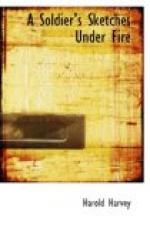[Illustration: The black tower.]
The sketch entitled “The Black Tower” exhibits the other side of the gateway, and shows the road with the caretaker’s house, and our barricades to the right.
DILAPIDATED QUARTERS.
[Illustration: Where the trap was set.]
The part of the distillery buildings standing in its yard interior, where we blew up the tower and the spy, and into which the enemy had hoped to entice us to our destruction, was very old, very dirty, and very dilapidated—in fact, had apparently not been used for years. We had to sleep in it for several nights, and made the acquaintance of thousands of rats and other pests. There was only one staircase, by which some hundreds of troops had to find access and egress. A curious fact was that the fumes of the spirit had eaten so into the woodwork, which was generally worm-eaten and rotten, that to strike a light near it was to incur the danger of igniting it and burning the building down. But our boys found a walled-in yard in the background covered by a tarred roof which had no windows, and this they converted into a smoke-room. Roominess and a covering offered a welcome change from the mud, dirt, and rain of the trenches, and Tommy’s spirits kept up, in spite of all shortcomings. Our musical evenings continued as before, and we thoroughly enjoyed being able to stretch our legs. In fact, we had become quite reconciled as well as quite used to our surroundings by the time we were called away. Afterwards we looked back with pleasure to our stay in the distillery, for we were much worse off in the next place at which we were stationed. We were moved from here into one of the most dangerous positions in the line at Ypres.




